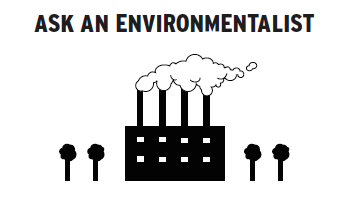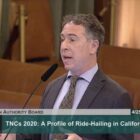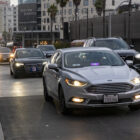I know airplanes burn enormous amounts of fuel. What’s the carbon footprint comparison between driving the 400 miles between San Francisco and Los Angeles and flying? — Jessica, the Marina
This kind of carbon calculus is notoriously tricky, but very roughly speaking, flying to L.A. will spew about two and a half times more carbon into the atmosphere than driving there — about 435 kg of CO2 versus about 180 kg. Still, getting exact numbers would mean considering an almost endless web of progressively more maddening variables. For one thing, airplanes release their exhaust higher in the atmosphere rather than at road level, and climatologists believe this intensifies the effect of its greenhouse gass emissions two or threefold. Weight must also be taken into account: a Boeing 757 full of pregnant women will burn more fuel than one containing a single elderly woman.
On the other hand, how heavy is the car you’re driving? And how fuel-efficient? Is it a belching old sedan? A Prius? OK, but is the Prius’ trunk filled with iron ore? And what about carpooling? Do you have any LA-bound friends? Can you round up strangers and vagrants through Craigslist, or even pick up early-adopting hobos along the way through nifty new iPhone ridesharing apps like Avego? Bear in mind that the more people you pack in, the less carbon you emit per head, although added weight, as with airplanes, means you burn more fuel. But how many can you fit in a car? Two? Three? Seven? Go far enough into this thought experiment, and you wind up awed and chastened by the ecological unassailability of the clown car.
Can I compost my old clothing? — Lisa, Glen Park
Clothing is not accepted by San Francisco’s citywide composting program. But a small number of scraps of 100 percent cotton clothing, provided they’re free of dyes and bleaches, should mix into your own backyard compost just fine. Also, coconut bikinis!
The Safeway near my house has a sign that reads, “This store is powered entirely by wind power.” What’s up with that? It’s got to be hooked up to the same electrical grid as the rest of the city, right? Do they have a bunch of people farting into it or something? — Ruben, Lower Haight
Oh come on, Ruben.
I can tell by your tone that you already know the answer: It’s not true. But it’s not exactly a lie either, and it’s not nearly as brazenly deceptive as some of the other green-washing we’re accustomed to seeing on a daily basis – and which you, Ruben, have apparently been using as a leather strop against which to sharpen your gleaming snark razor.
Since 2005, the Safeway Corporation has been a part of an EPA program called Green Power Partnership, which requires businesses and organizations to purchase a certain amount of renewable energy. Actually, Safeway buys something called RECs – renewable energy certificates — which function like currency, corresponding to the price of generating a certain amount and type of clean energy and entitling the buyer to the bragging rights of having produced or used it.
Right now, Safeway is buying the REC-equivalent of 90 million kilowatt hours of wind power, which is enough electricity to power all its stores in San Francisco, its corporate headquarters and then some. Of course, all the wind power production that Safeway underwrites merely gets fed from those various wind turbines into the electrical grid, where it congeals with electrons from every other conceivable energy source, and they all begin zipping around madly and indiscriminately, like the sperm in that Woody Allen movie, spurting out of walls everywhere whenever something switches on. Thus, the probability that your neighborhood Safeway is powered at all times, exclusively, by wind power is damn close to zero. Maybe some Safeway-funded wind power streams into a Safeway; maybe none of it does. Maybe, in some twisted, grocerial cosmic joke, it all ends up powering the Trader Joe’s on Masonic. Still, my contact at the EPA explains: “Safeway’s claim to be ‘running on wind power’ is a statement we support.”
In the early ’90s, the hole in the ozone layer and aerosol cans were all anyone talked about in terms of environmental issues. Now it’s hardly mentioned. Is it fixed? Is it still growing? — James, Glen Park
Actually, it was the mid-’80s. But 43 countries came together in 1987 to limit the emissions of chlorofluorocarbons and other ozone-depleting chemicals, averting what might have otherwise been a disastrous situation by now, if not fixing it outright. The Montreal Protocol, as this agreement is known, is an inspiring precedent to keep in mind as we face more severe environmental threats.
Clearly no progress would have been possible without such swift, multinational cooperation, and without the support of the general populace, which, as is now apparent, really rallied behind scientists’ anti-aerosol findings because they saw a chance to stop women from cementing their bangs into hideous waves and towers with hairspray.
We can’t rest on our laurels though. This year scientists raised new alarms about another potent threat to the ozone layer not addressed by the Montreal Protocol: nitrous oxide gas. If the world can once again put our differences aside and band together, it will be miraculous. It will also be just the kind of clear global referendum on Phishheads and dentists so many of us have longed for.
A version of this article was published in the summer 2010 pilot edition of the San Francisco Public Press newspaper. Read select stories online, or buy a copy.










